Sojourning Sacred Ground: Tips on Visiting Isandhlwana and Rorke’s Drift
 David Rattray’s Guidebook to the Anglo-Zulu War Battlefields is an indispensible companion for those planning to visit the battle sites. It includes history of the sites, detailed battlefield maps, and directions to such places as the Ultimatum Tree, the Fugitives Trail, Hlobane, Khambula, the death site of the Prince Imperial, and Ulundi. The book, which can be purchased online, also contains sections on the memorials in kwaZulu-Natal, hard-to-find grave sites, and guidelines for travelers sojourning in some of the more isolated sites where visitors are rare.
David Rattray’s Guidebook to the Anglo-Zulu War Battlefields is an indispensible companion for those planning to visit the battle sites. It includes history of the sites, detailed battlefield maps, and directions to such places as the Ultimatum Tree, the Fugitives Trail, Hlobane, Khambula, the death site of the Prince Imperial, and Ulundi. The book, which can be purchased online, also contains sections on the memorials in kwaZulu-Natal, hard-to-find grave sites, and guidelines for travelers sojourning in some of the more isolated sites where visitors are rare.
When traveling in South Africa, remember to bring along transformers and adaptors for any electronic devices that need recharging, such as cameras and computers. The battlefields as well as the guesthouses have unique gifts and historical items for purchase, but remember to save the receipts to get reimbursed at the airport for the value-added taxes that are incurred. Credit cards are accepted at the museum shops at Isandhlwana and Rorke’s Drift, but paying cash is much more efficient.
{default}-tbnl.jpg) For those wishing to stay longer and see other sites of South African history, the area is littered with other battlefields of the Anglo-Zulu conflict, as well as those of both Boer Wars and the violent clashes amongst Afrikaans and the indigenous peoples. Or take a step back in time and enter the world of Shaka, Founder of the Zulu Nation, at the authentic re-creation of his Great Kraal overlooking the Umhlatuze Lake, between Eshowe and Melmoth. “Shakaland” is a unique resort built on the set of the movies Shaka Zulu and John Ross. Shaka himself is buried in the city of Stanger, only about 40 minutes north of Durban.
For those wishing to stay longer and see other sites of South African history, the area is littered with other battlefields of the Anglo-Zulu conflict, as well as those of both Boer Wars and the violent clashes amongst Afrikaans and the indigenous peoples. Or take a step back in time and enter the world of Shaka, Founder of the Zulu Nation, at the authentic re-creation of his Great Kraal overlooking the Umhlatuze Lake, between Eshowe and Melmoth. “Shakaland” is a unique resort built on the set of the movies Shaka Zulu and John Ross. Shaka himself is buried in the city of Stanger, only about 40 minutes north of Durban.
Finally, visiting the veldt, the South African grasslands, is a mandatory hajj (sacred journey or piligrimage) for buffs and scholars of Queen Victoria’s most famous “little war” and is equally as enjoyable for their companions, who perhaps don’t feel the ghosts of the old barracks, bivouacs and battles echoing through their souls.
Erich Wagner is a Major in the United States Marine Corps, and a graduate of the Fletcher School of Law and Diplomacy. In the past decade as an infantry officer, he has served in defense of the American Embassy in Panama, trained foreign personnel in Croatia, Australia, Argentina, Korea, Japan, Curacao, and most recently, Iraq. In 2000 The Anglo-Zulu War Historical Society published his article entitled “A Lion Disheveled: The Response of the British Press to the Battle of Isandhlwana.”



I have to second the recommendation of the Rattray lodge and materials. I’ve listened to his excellent “Day of the Dead Moon” many, many times and believe you would be hard pressed to find someone more knowledgeable of the geography and history of the Zulu war.